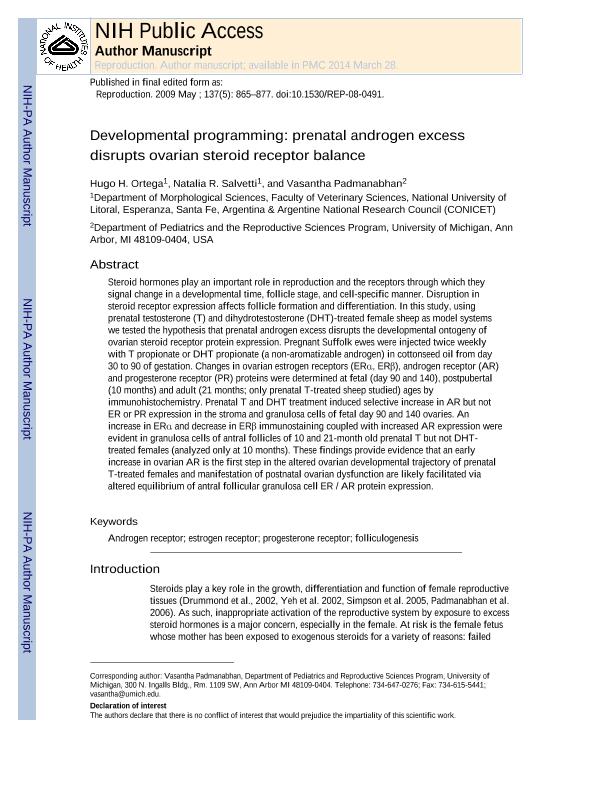Mostrar el registro sencillo del ítem
dc.contributor.author
Ortega, Hugo Hector

dc.contributor.author
Salvetti, Natalia Raquel

dc.contributor.author
Padmanabhan, Vasantha

dc.date.available
2020-02-15T22:48:09Z
dc.date.issued
2009-12
dc.identifier.citation
Ortega, Hugo Hector; Salvetti, Natalia Raquel; Padmanabhan, Vasantha; Developmental programming: Prenatal androgen excess disrupts ovarian steroid receptor balance; BioScientifica; Reproduction; 137; 5; 12-2009; 865-877
dc.identifier.issn
1470-1626
dc.identifier.uri
http://hdl.handle.net/11336/97713
dc.description.abstract
Steroid hormones play an important role in reproduction and the receptors through which they signal change in a developmental time, follicle stage, and cell-specific manner. Disruption in steroid receptor expression affects follicle formation and differentiation. In this study, using prenatal testosterone (T) and dihydrotestosterone (DHT)-treated female sheep as model systems, we tested the hypothesis that prenatal androgen excess disrupts the developmental ontogeny of ovarian steroid receptor protein expression. Pregnant Suffolk ewes were injected twice weekly with T propionate or DHT propionate (a non-aromatizable androgen) in cottonseed oil from days 30 to 90 of gestation. Changes in ovarian estrogen receptors (ER; ESR1, ESR2), androgen receptor (AR) and progesterone receptor (PGR) proteins were determined at fetal (days 90 and 140), postpubertal (10 months), and adult (21 months; only prenatal T-treated sheep studied) ages by immunohistochemistry. Prenatal T and DHT treatment induced selective increase in AR but not ER or PGR expression in the stroma and granulosa cells of fetal days 90 and 140 ovaries. An increase in ESR1 and decrease in ESR2 immunostaining coupled with increased AR expression were evident in granulosa cells of antral follicles of 10- and 21-month-old prenatal T but not DHT-treated females (analyzed only at 10 months). These findings provide evidence that an early increase in ovarian AR is the first step in the altered ovarian developmental trajectory of prenatal T-treated females, and manifestations of postnatal ovarian dysfunction are likely facilitated via altered equilibrium of antral follicular granulosa cell ER/AR protein expression.
dc.format
application/pdf
dc.language.iso
eng
dc.publisher
BioScientifica

dc.rights
info:eu-repo/semantics/openAccess
dc.rights.uri
https://creativecommons.org/licenses/by-nc-sa/2.5/ar/
dc.subject
OVARIAN FAILURE
dc.subject
ANDROGEN
dc.subject
OVINE
dc.subject.classification
Ciencias Veterinarias

dc.subject.classification
Ciencias Veterinarias

dc.subject.classification
CIENCIAS AGRÍCOLAS

dc.title
Developmental programming: Prenatal androgen excess disrupts ovarian steroid receptor balance
dc.type
info:eu-repo/semantics/article
dc.type
info:ar-repo/semantics/artículo
dc.type
info:eu-repo/semantics/publishedVersion
dc.date.updated
2020-02-13T18:56:34Z
dc.journal.volume
137
dc.journal.number
5
dc.journal.pagination
865-877
dc.journal.pais
Reino Unido

dc.journal.ciudad
Cambridge
dc.description.fil
Fil: Ortega, Hugo Hector. Universidad Nacional del Litoral. Facultad de Ciencias Veterinarias. Departamento de Ciencias Morfológicas. Laboratorio de Biología Celular y Molecular; Argentina
dc.description.fil
Fil: Salvetti, Natalia Raquel. Universidad Nacional del Litoral. Facultad de Ciencias Veterinarias. Departamento de Ciencias Morfológicas. Laboratorio de Biología Celular y Molecular; Argentina
dc.description.fil
Fil: Padmanabhan, Vasantha. University of Michigan; Estados Unidos
dc.journal.title
Reproduction

dc.relation.alternativeid
info:eu-repo/semantics/altIdentifier/url/http://www.reproduction-online.org/cgi/pmidlookup?view=long&pmid=19261835
dc.relation.alternativeid
info:eu-repo/semantics/altIdentifier/doi/http://dx.doi.org/10.1530/REP-08-0491
Archivos asociados
